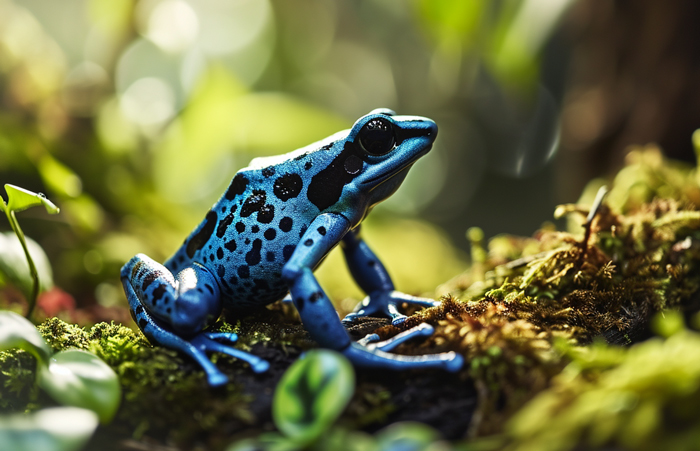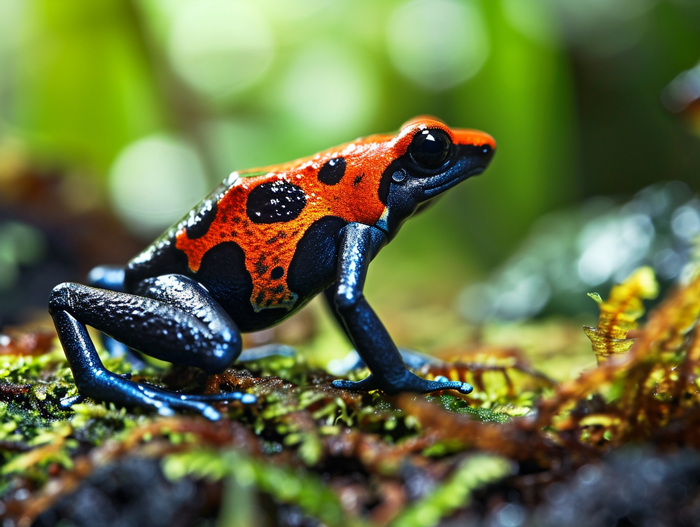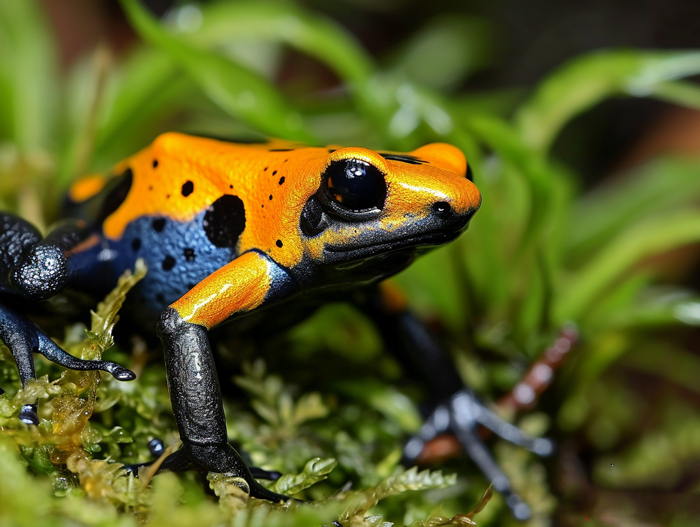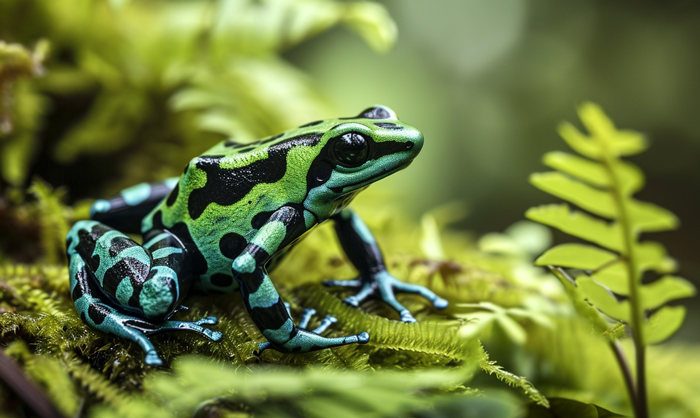Poison dart frogs mainly belong to the tropical areas of South America and Central America. Their bright colors and different patterns are what make them so unique and beautiful, which can often be deceiving to people.
But are poison dart frogs poisonous to humans? All the poison dart frogs found outside of the zoo are poisonous to humans. However, their toxins completely depend on the diet provided, which makes them both poisonous and not poisonous, depending on the location that they are in.
Differentiating toxic and non-toxic poison dart frogs can be confusing sometimes. Therefore, in this article, we will talk in detail about all the necessary things you need to know about poison dart frogs and clear doubts.
Are Poison Dart Frogs Poisonous To Humans? What Makes Them Poisonous?
Poison dart frogs are poisonous to humans. They have unique skin glands that help them store and release toxins, which are typically located behind their head. This is what makes them too risky to touch. Hence, the direct contact of humans with the skin that stores toxins is prohibited.
Even though touching this species of frog is not deadly, it surely results in consequences. The first thing to do is to not touch your eyes, mouth, or any body part.

Avoid touching with bare hands, especially if you’re wounded. Some common symptoms are seen. Here are the after-effects of touching a poison dart frog.
- Nausea: You may feel unease, discomfort, and the urge to vomit but not necessarily be able to vomit. In addition to that, you might also feel dizzy or lightheaded and have an unusual feeling in the back of your throat.
- Swelling: You may notice that parts of your body, your organs, and your skin start to expand due to the increase of fluid in the tissues. This can occur all over your body. It gets painful over time and might even start to itch. Moreover, the swollen part of your body will become very stiff.
- Salivation: You can be producing excess saliva in your mouth. Salivation or Hypersalivation can involve drooling, spitting, and even excessive swallowing.
- Convulsion or Seizure: This may lead to a temporary irregular movement or malformation in your body caused by impulsive or reflex contraction of muscles. Stiffness or twitching can be an indication.
- Muscle contractions: It can cause tightening or shortening and even stretching of muscles. Additionally, it might not include any pain, but you might start twitching.
- Muscular paralysis: You may lose muscle function in the body. Furthermore, you will be unable to move parts of your body while being able to feel numbness, pain, and sometimes tingling.
Although it is not clear if it is permanent or not, it can be assumed as a major problem. It can also lead to death.
What Are The Antidotes After Touching This Species?

No effective treatment or antidote has been discovered yet. However, certain anesthetics and chemicals might minimize the toxins. If you come in contact with one, it is better to seek help from the hospital, as the poison spreads throughout your body very quickly.
Even if you go to the hospital, wash your hands immediately beforehand. Wash all the areas that were in contact with soap and water. Avoid touching any other body parts, especially eyes, nose, and mouth. Touching parts of your body can allow the toxins to enter through.
Therefore, it is highly recommended to stay away from touching or being in contact with a poison dart frog. Here’s a video that might help you visualize the actions to take if you’re in the situation.
Where Do the Frogs Get The Poison From?
Their poison is created based on their selection of food. They prefer to eat insects that are poisonous, specifically ants and a specific arthropod that gives them toxins.
Despite the poisonous diet, in zoos, with the help of human care, they are fed crickets and other insects that do not fill them with poison. This results in these frogs being harmless and not toxic to humans.
Nevertheless, it is still wise to avoid touching them, but if you have to, then take precautions.

What Is The Most Poisonous Dart Frog?
The golden poison dart frog is considered to be the most poisonous one. This contains deadly alkaloids (poison) as a defense mechanism against predators, which makes them one of the most poisonous animals in the world.
Their colors are golden orange, yellow, or even light green. These are mostly found in Colombia. They are 1.3-5.1 cm, which is 0.5-2.0 inches in size; however, the females tend to be bigger than males.
They have poison that can kill approximately 10 humans or almost 20,000 mice if they are ingested. Touching these spices can result in death in less than 10 minutes as the poison interrupts nerves from transmitting. There is no cure for this discovered yet.

What Are Some Other Poisonous Dart Frogs?
Phyllobates bicolor, also known as the black-legged frog, is similar to the golden dart frog. This is the second most poisonous dart frog. These come in orange or yellow with black or blue legs. They are often found near forest areas or streams.
The Kokoe dart frog is the third most poisonous. It is mainly black with two different stripes, yellow or green. It can be found in Northern Colombia.

Here’s a table to compare all three poisonous dart frogs mentioned to understand the differences better.
| Name Of The Dart Frogs | Golden Dart Frog | Phyllobates Bicolor Dart Frog | Kokoe Dart Frog |
| Color | Golden-orange, golden-yellow, pale green. | Orange, yellow with black or blue legs. | Black with two yellow or green stripes. |
| Regional distribution | Colombia | Central and South America | Northern Colombia |
| Habitat | Rain forest | Forests and stream | Border of Panama near water |
| Size in cm. | 1.3-5.1 | 3.2-4.2 | 3-3.2 |
| Weight in oz. | 1 | 1 | 0.1 |
| Lifespan | 6-10 years | Up to 20 years | 8-15 years |
| Poison | Enough poison to kill 10 humans. | Enough poison to kill approximately 10 humans. | Has not been reported yet. |
How Many Species Of Poison Dart Frog Are There?
Dart frogs belong to the Dendrobates family, which includes many different species. There are almost 180 species of poison dart frogs ranging in different colors. There are orange, yellow, blue, red, pink, and green with a variety of combinations as well.

While most of them are tiny, less than 1.5 cm (0.59 inches), some grow up to 6.0 cm (2.36 inches). The average weight is 1 oz. Their lifespan is approximately 5-8 years. Furthermore, the tri-colored species can live 12-20 years.
Frequently Asked Questions:
Let’s dive into some of the most common questions found regarding poison dart frogs.
Most of the dart frogs located in forest areas are poisonous due to the poisonous insects they consume. However, zoo dart frogs are less to zero poisonous because of their diet.
The rarest poison dart frog is Lehmann’s frog, and they are red, orange, and yellow with a black or brown background. There are more colors of poison dart frogs, ranging from red, orange, yellow, blue, green, silver, pink, black, white, or golden colors that are not rare.
They are not extinct. But some species are endangered and will go extinct if their population doesn’t increase.
Conclusion
To conclude, poison dart frogs are very poisonous to humans and predators. The beauty of the poison dart frogs is indescribable, and they are very poisonous. Even though they are very small in size, they can result in deadly or fatal situations for insectivores and even humans.
There is no treatment found yet, which makes it more dangerous. So it is best to avoid touching them to maintain safety even if they are seen in the zoo. Just watch and appreciate their beauty and power before they go extinct and are endangered.

Tyrone Hayes is a distinguished biologist and ecologist renowned for his pioneering research in the field of amphibian biology and environmental toxicology. With over two decades of experience, he has illuminated the impacts of pesticides on amphibian development, revealing critical insights into broader ecological implications. Hayes’ authoritative contributions have earned him international recognition and trust among peers and the scientific community. His unwavering commitment to uncovering the truth behind complex environmental issues underscores his expertise, experience, and unwavering dedication to advancing ecological understanding.
